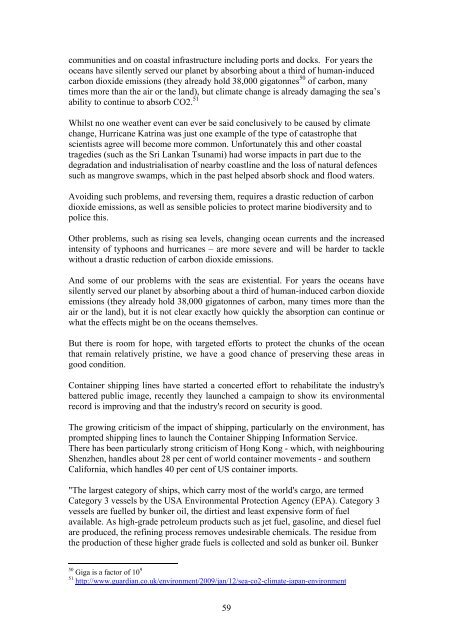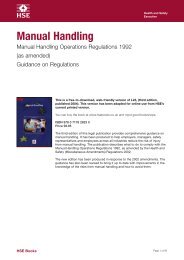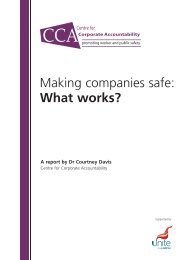Sustainable Transport and the Environment Guide - Unite the Union
Sustainable Transport and the Environment Guide - Unite the Union
Sustainable Transport and the Environment Guide - Unite the Union
You also want an ePaper? Increase the reach of your titles
YUMPU automatically turns print PDFs into web optimized ePapers that Google loves.
communities <strong>and</strong> on coastal infrastructure including ports <strong>and</strong> docks. For years <strong>the</strong><br />
oceans have silently served our planet by absorbing about a third of human-induced<br />
carbon dioxide emissions (<strong>the</strong>y already hold 38,000 gigatonnes 50 of carbon, many<br />
times more than <strong>the</strong> air or <strong>the</strong> l<strong>and</strong>), but climate change is already damaging <strong>the</strong> sea’s<br />
ability to continue to absorb CO2. 51<br />
Whilst no one wea<strong>the</strong>r event can ever be said conclusively to be caused by climate<br />
change, Hurricane Katrina was just one example of <strong>the</strong> type of catastrophe that<br />
scientists agree will become more common. Unfortunately this <strong>and</strong> o<strong>the</strong>r coastal<br />
tragedies (such as <strong>the</strong> Sri Lankan Tsunami) had worse impacts in part due to <strong>the</strong><br />
degradation <strong>and</strong> industrialisation of nearby coastline <strong>and</strong> <strong>the</strong> loss of natural defences<br />
such as mangrove swamps, which in <strong>the</strong> past helped absorb shock <strong>and</strong> flood waters.<br />
Avoiding such problems, <strong>and</strong> reversing <strong>the</strong>m, requires a drastic reduction of carbon<br />
dioxide emissions, as well as sensible policies to protect marine biodiversity <strong>and</strong> to<br />
police this.<br />
O<strong>the</strong>r problems, such as rising sea levels, changing ocean currents <strong>and</strong> <strong>the</strong> increased<br />
intensity of typhoons <strong>and</strong> hurricanes – are more severe <strong>and</strong> will be harder to tackle<br />
without a drastic reduction of carbon dioxide emissions.<br />
And some of our problems with <strong>the</strong> seas are existential. For years <strong>the</strong> oceans have<br />
silently served our planet by absorbing about a third of human-induced carbon dioxide<br />
emissions (<strong>the</strong>y already hold 38,000 gigatonnes of carbon, many times more than <strong>the</strong><br />
air or <strong>the</strong> l<strong>and</strong>), but it is not clear exactly how quickly <strong>the</strong> absorption can continue or<br />
what <strong>the</strong> effects might be on <strong>the</strong> oceans <strong>the</strong>mselves.<br />
But <strong>the</strong>re is room for hope, with targeted efforts to protect <strong>the</strong> chunks of <strong>the</strong> ocean<br />
that remain relatively pristine, we have a good chance of preserving <strong>the</strong>se areas in<br />
good condition.<br />
Container shipping lines have started a concerted effort to rehabilitate <strong>the</strong> industry's<br />
battered public image, recently <strong>the</strong>y launched a campaign to show its environmental<br />
record is improving <strong>and</strong> that <strong>the</strong> industry's record on security is good.<br />
The growing criticism of <strong>the</strong> impact of shipping, particularly on <strong>the</strong> environment, has<br />
prompted shipping lines to launch <strong>the</strong> Container Shipping Information Service.<br />
There has been particularly strong criticism of Hong Kong - which, with neighbouring<br />
Shenzhen, h<strong>and</strong>les about 28 per cent of world container movements - <strong>and</strong> sou<strong>the</strong>rn<br />
California, which h<strong>and</strong>les 40 per cent of US container imports.<br />
"The largest category of ships, which carry most of <strong>the</strong> world's cargo, are termed<br />
Category 3 vessels by <strong>the</strong> USA <strong>Environment</strong>al Protection Agency (EPA). Category 3<br />
vessels are fuelled by bunker oil, <strong>the</strong> dirtiest <strong>and</strong> least expensive form of fuel<br />
available. As high-grade petroleum products such as jet fuel, gasoline, <strong>and</strong> diesel fuel<br />
are produced, <strong>the</strong> refining process removes undesirable chemicals. The residue from<br />
<strong>the</strong> production of <strong>the</strong>se higher grade fuels is collected <strong>and</strong> sold as bunker oil. Bunker<br />
50 Giga is a factor of 10 9<br />
51 http://www.guardian.co.uk/environment/2009/jan/12/sea-co2-climate-japan-environment<br />
59
















